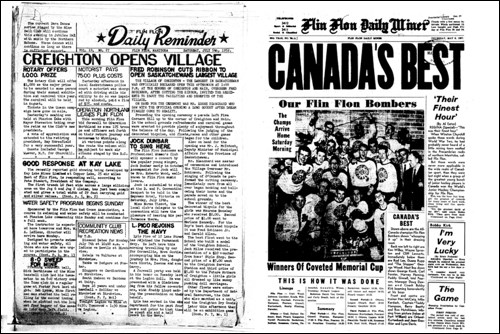The late 1940s and early 1950s were a time of new beginnings for Flin Flon.
The Second World War had ended, sparking a population explosion: the baby boom. Hudson Bay Mining and Smelting Co., Ltd (HBM&S) continued to churn along far past its life expectancy.
Cultural changes were also becoming apparent as the first generation of Flin Flonners – some of whom had relocated from distant lands and spoke poor English – gave way to their sons and daughters.
Vasti Lamb, the daughter of Swedish immigrants, is grateful to have come of age in Flin Flon during this era.
“Everybody knew everybody [but] everybody respected everybody’s privacy, if you want to call it that,” recalls Lamb, 84. “We all minded our own business, but we all got together and did things. There were a lot of activities for both young and old, but it was quiet, it was easygoing.”
With the arrival of television still years away, Lamb and her friends kept busy with books along with ample homework from their classes at the local high school, Hapnot Collegiate.
They would often catch a movie – a western or a Doris Day picture, perhaps – at one of the local theatres.
“A lot of us spent our time at the theatres on the weekends,” says Lamb. “It was quite a bit [packed] and most of us were teenagers because the parents would go at night and we would go Saturday afternoon and Saturday night, maybe.
“They brought in quite decent movies, really they did, so we were quite well entertained.”
Lamb was also a loyal devotee of the Glee Club, which put on theatrical productions that are revered to this day.
“They did the best they could and they did very well,” she says. “Their standards were as high as the standards we have here [today] for the [Flin Flon Community Choir]. It was more or less the same. We had a lot of talented people then, too, and we have a lot of talented people now.”
Radio was another dominant form of entertainment and information. Lamb recalls tuning in programs such as Ma Perkins,
The Shadow andThe Lone Ranger.
“Of course Pa had to listen to his news, so when the news came on…it was his radio, not ours,” she says with laugh.
In the summers, Lamb worked at a popular concession stand known as Aunt Mary’s. Located on South Hudson Street, Aunt Mary’s drew much of its business from the youth travelling to and from Phantom Lake.
“I was selling ice cream to all the kids that were going to Phantom Lake,” she says. “Most of the kids at my time, we spent hours at Phantom Lake, swimming. We’d spend all day there and come home at suppertime.”
Like many local teens of the era, Lamb loved the outdoors. When she wasn’t at Aunt Mary’s, she could usually be found at the family cabin at Bakers Narrows.
“We did a lot of boating, fishing and we just sort of R and R’ed there,” she says.
A principal feature of Flin Flon’s landscape continued to be the two HBM&S smoke stacks, which puffed away like giant cigars near the town site.
“Main Street was absolutely blue – it was so, so smoggy it was blue,” recalls Lamb. “It all depended on the wind. If the wind was going that way, we were fine. If the wind was coming this way, phew!”
Lamb was a studious high school student, but she never finished grade 12 – nor did she have to. Back then, she was able to enroll in nursing school in Winnipeg with a full grade 11 and half of a grade 12.
Moving to the big city was a scary culture shock for Lamb, who later found her true calling as a lab and x-ray technician. She now lives in Creighton.
Hockey supremacy
“Canada’s Best” blared the banner headline. Like all of Flin Flon, the Daily Miner newspaper was celebrating the Bombers’ May 1957 win of the Memorial Cup national championship.
The underdog Bombers bested the Ottawa Junior Canadiens in dramatic fashion, winning the seventh and deciding game by just one goal.
The victory was made all the more surprising by the fact that the Bombers, though complemented by some late additions from other clubs, were comprised mostly of Flin Flon boys.
Coached by Bobby Kirk and boasting talents such as Patty Ginnell, Ted Hampson, George Konik and Harvey Fleming, the Bombers were the toast of Flin Flon that spring.
In 2007, that team’s milestone was forever immortalized when the Whitney Forum – the Bombers’ home rink – was given the street address 57 Memorial Cup Drive.
Farewell, Tom
Flin Flon bid farewell to a key figure in its history when Tom Creighton passed away on April 6, 1949. Here is how the Flin Flon Daily Reminder reported news of his death:
Truly a pioneer of the North, Tom Creighton, prospector and exploration head, passed away here today in the Hudson Bay Mining and Smelting Company Hospital following a lengthy illness.
Mr. Creighton, who discovered the huge ore body at Flin Flon which has produced thousands of tons of copper, zinc and other metals under the production operation of the Hudson Bay Mining and Smelting Company, died at the age of 75 years at approximately 11 this morning.
Known and respected by hundreds of mining men throughout the continent, a great friend of the prospectors who roam the wastelands, and a respected citizen, Creighton’s funeral will be held Saturday at the St. James Anglican Church.
Three years after Tom Creighton passed away, the neighbouring community named in his honour was granted village status. A ribbon-cutting ceremony on
July 5, 1952 made it official.
Note: It is acknowledged today that trapper David Collins showed the outcroppings of the Flin Flon ore body to Tom Creighton, who then staked the claims.




